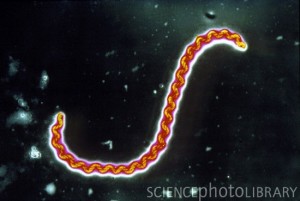
Leptospirosis and Lyme Disease
It’s going to be spring time, which means the weather will FINALLY start to warm up! This is great for those of us who hate the winter weather, however, it’s also the time of year when the parasites begin to emerge from their winter hibernation and begin their lifecycles once again. These lifecycles may involve our pets, so it’s important to understand how these parasites work and how we can protect our pets! In this installment I will talk a bit about two very infectious diseases that are not always on our radar as being potential issues for our pets, but they ARE! These diseases are Leptospirosis and Lyme Disease. They are both in our GTA/Mississauga/Oakville/Milton area and their incidence in our pets is increasing every year.
.
LEPTOSPIROSIS
Leptospirosis (or “Lepto” for short) is a disease that is spread through the urine of animals that are infected with the Leptospira bacteria. This can include ANY wildlife such as squirrels, raccoons, foxes, deer, etc. as well as other pet animals. This bacteria hangs out in the kidneys and is transmitted by ingestion of urine, which usually comes from drinking out of puddles where urine has collected or by licking paws after walking through an area where an infected animal has urinated. Spring and fall months are the time when our pets are most likely to become infected because the weather is wet. This allows the Leptospira bacteria to live in the environment for longer periods. In addition, the wildlife is out and about getting to their spring/fall activities, making it more likely that our pets are going to come into contact with their urine in one way or another.
Above is a microscopic image of the Leptospira Bacteria that causes Leptospirosis
Once ingested, the Lepto bacteria spread throughout the entire body. They reproduce in the liver, central nervous system, kidneys, eyes, and reproductive system. After infection through ingestion, a bacterial infection of the blood will develop, but these symptoms soon resolve with the reactive increase of antibodies (the body’s defense system). The extent to which this bacteria affects the organs will depend on your pet’s immune system and its ability to deal with the infection. If the body can fight the Lepto bacteria to prevent the animal from appearing ill, it can still remain in the kidneys. It will reproduce there and infect the urine. Infection of the liver or kidneys can be fatal for animals if the infection progresses, causing severe damage to these organs and ultimately, death.
Another important thing to realize is that this disease is ZOONOTIC, meaning that it can be passed to humans as well! This is very important if your pets are around children or older/immunocompromized people as they are much more susceptible to the disease. That being said, even healthy people can become infected and have major issues secondary to this disease.
The GOOD news is that we have an effective and safe vaccination against the most common strains of Leptospirosis that your dog can receive. This vaccination is given to dogs that are at over 9 weeks of age (we usually give and then a booster is given 3-4 weeks later. After this initial vaccine series, it must be repeated once every year to maintain good immunity. Unfortunately there is currently no vaccination against Lepto for cats (yet another reason to keep your kitty cat INSIDE!). We highly recommend this vaccination to all of our canine patients to keep them protected and it’s important that it is in place before the springtime comes! DO NOT EVER let your pet drink from puddles or outdoor standing water sources as this increases their risk of contact with the bacteria (as well as many other bacteria and parasites)!
LYME DISEASE
Lyme disease is something that isn’t really on our radar as far as a typical disease that our pets can get, but since we have experienced a boom in the tick population in our area, it’s something that we are starting to see more and more of.
Lyme disease is spread by Ticks (specifically the Deer Tick/Blacklegged Tick or “Ixodes Scapularis” if you want to be scientific) and it’s a disease that can cause a lot of pain and discomfort in our pets. It also turns out that humans can get Lyme disease as well, so if our pets are at risk, it’s important to remember that our human family members are at risk too. In our pets Lyme disease can cause painful joints, fever, kidney failure, and in some cases heart disease and neurologic disease. It is very painful and it can be fatal in some cases if left untreated.
Lyme disease itself is a bacteria that the ticks carry with them and transmit to whichever animal they decide to feed off of. They will crawl around on their host animal, decide that they are hungry, bury their mouth parts under the skin, and begin taking a blood meal from their host. It’s after this bite that we need to worry about the transmission of Lyme disease. Generally a tick has to be feeding for at least 24 hours for them to transmit Lyme disease.
Our pets can come into contact with these little blood suckers anywhere where wildlife lives, and that INCLUDES our back yards, on the street on walks, on hiking trails, etc. Anywhere where a bird, squirrel, raccoon or a mouse can be, ticks can also be found as these are the creatures that the tick needs to complete its life cycle. Generally a tick will feed on several different hosts. After each blood meal the tick will fall off one host, molt into its next form, and then be ready to jump onto the next host to do it all over again. Each time they do this they can transmit Lyme disease if they are infected, and the Deer tick will complete this cycle 3 times before they reach adult form and are ready to mate and lay eggs.
You may be thinking “well how could I possibly not notice a tick feeding off of myself or my pet if they need to be stuck on for 24 hours before Lyme disease is transmitted?” and the answer to this is that these guys are generally painless, stealthy, and they can be extremely small in their young nymph form. This means that you may well NOT see them on yourself or your pet and they will be there, feed, and fall off before you know it!
Above is a picture to show you just how small these guys can be!
One of the most important things for us as pet owners and family members to do is actively PREVENT our animals from getting ticks and potentially Lyme disease. Remember, when that tick falls off your pet they will be looking for another host for their next blood meal, and that next host could be a human family member!
We have excellent medications to give our pets now to ward off ticks and kill them before they have a chance to transmit Lyme disease, among other diseases they can carry. The most effective treatments we have are for DOGS only at this time, but there will be cat tick prevention in the not-too-distant future. The easiest and best products that we have at this time are called NEXGARD and BRAVECTO. These are simple chewable treats that will begin to kill ticks on your dog as soon as they start to take a blood meal, making it impossible for them to transmit the Lyme disease. NexGard is given once per month and Bravecto is given once every 3 months to protect your dog against ticks. There are also topical products like REVOLUTION that can help, but they are not labeled to kill the specific tick that is responsible for transmitting Lyme disease. In addition there is a Lyme disease vaccination that is available and effective for our dogs to help to protect them against the disease.
ALWAYS REMEMBER: PREVENTION IS THE KEY!
Ask us about NexGard, Bravecto and Revolution when you are in this spring for your heartworm 4DX testing and we can decide if it is right for your pet!
Dr. Christine Nawas, BSc. DVM
Associate Veterinarian
Erin Mills Pet Hospital
(c) Erin Mills Pet Hospital





